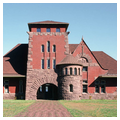Union Depot is located on the city's main thoroughfare within view from the front doors of the businessmen who promoted it. The Richardsonian Romanesque depot of red brick and reddish-brown variegated raindrop Jacobville sandstone stands on the former site of the Blodgett and Pryne sawmill, near the Central Wharf on the shoreline of Muskegon Lake. A network of tracks was laid on the north, and walks once connected it to the docks that stretched into Muskegon Lake. Spacious walks led from the streets to the depot. The depot has a steeply pitched hipped roof with wide projecting eaves, which originally was covered with slate. Rising through it, on the main facade, is a great squat square central tower with battered walls; cut into it, through a massive Richardsonian arch, is a cavelike recessed entrance. The interior was finished in oak and black ash woodwork, bronze and steel grillework, paneled and tinted steel ceilings, and massive ornamental fireplaces.
Muskegon businessmen worked eagerly for the construction of the Union Depot and offered various railroads—the Chicago and West Michigan, the Muskegon, Grand Rapids and Indiana, and the Toledo, Saginaw and Muskegon—a financial incentive to build it where they did. Previously the city had been served by a small frame structure with a waiting room, and by then dilapidated and flimsy. The original design, prepared in 1893 by Sidney J. Osgood of Grand Rapids for a larger, more ornate pinnacled and dormered stone building with a tall tower, languished during the Panic of 1893. Work resumed in 1894 on Rush's scaled-back and revised plans for a station more modest in size. The depot served as the main railroad terminal for the city during the years when lumbering was declining. Eventually, in the early 1990s, after Amtrak discontinued service between Muskegon and Holland, Muskegon County acquired and restored the station. Today Union Depot has been recycled as the Muskegon County Convention and Visitors Bureau.





